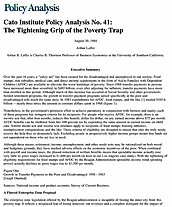Nonetheless, in the government’s persistent effort to achieve parsimony in conjunction with fairness and equity, each of these programs has stringent criteria for its recipients. For people who receive AFDC, for example, there is an income test that, after four months, reduces this benefit, dollar for dollar, on any earned income above $75 per month. AFDC benefits can be sheltered from this 100 percent tax by expending the same amount in earned income on child care. Similar means test and income test strictures apply to recipients of food stamps, housing subsidies, unemployment compensation, and the like. These criteria of eligibility are designed to ensure that only the truly needy receive the help they so desperately lack. Excluding people in progressively higher income groups means that funds are not squandered on those who are less in need.
Although these means, retirement, income, unemployment, and other needs tests may be rationalized on both moral and budgetary grounds, they have marked adverse effects on the economic incentives of the poor. When combined with payroll and income taxes, the phased reduction of welfare benefits means that spendable income actually rose very little as gross wages increased to $1,600 per month (at least in our Los Angeles case study). With the tightening of eligibility requirements for food stamps and AFDC by the Reagan Administration spendable income (total spending power) actually declines as gross wages rise to $1,300 per month.

